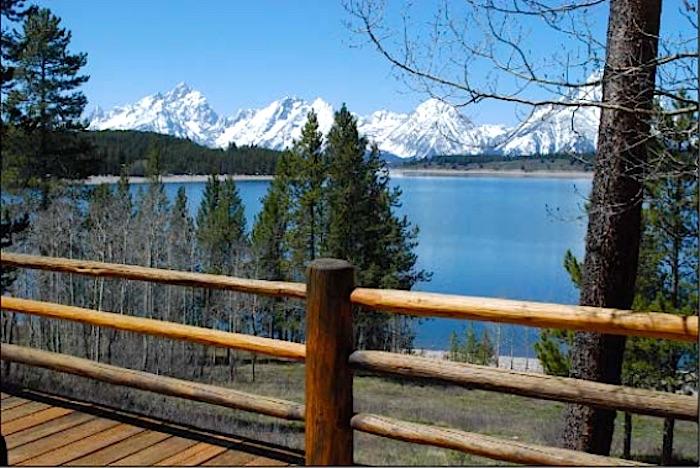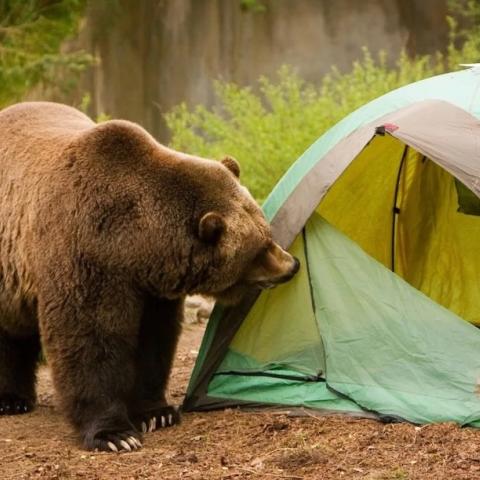
An Interior Department report has concluded that the National Park Service did not properly manage the Brinkerhoff Lodge in Grand Teton National Park, either when it came to nightly stays or safety and maintenance/DOI
With sweeping views of Jackson Lake and the jaw-dropping jagged Tetons from its deck, and the historic Molesworth furniture that fronts its stone fireplace, the historic Brinkerhoff Lodge in Grand Teton National Park would likely qualify as a 5-star resort property commanding hefty rental fees.
But the National Park Service wasn't always in the habit of charging the lodge's guests, who included Vice President Joe Biden and his family, nor did it provide the safety and security for the lodge that it should have, or properly oversee the use of its "museum quality" furnishings, according to a report from the Interior Department's Inspector General's Office.
IOG investigators were asked by members of Congress to look into how the log lodge was being managed after reports surfaced last year that the vice president had stayed there for free. Vice President Biden agreed three months later to pay the Park Service $1,200 for four nights' lodging there, though that didn't mute criticism over the practice of letting guests stay in the lodge for free. But the 39-page report released last month delved into more than just nightly rental rates for the Brinkerhoff Lodge, and found some key safety issues with the lodge, particularly around fire protection and security systems.
The Park has no documented security and protection plan specific to the Lodge. Although there have been no reported incidents of fire, breaking and entering, theft, or vandalism at the Lodge, recent media coverage has increased awareness of the Lodge and its furnishings, which warrants Park action to ensure the Lodge and its contents are properly secured and protected.
The Lodge has no alarm or automated security alert system and is secured solely by locks on its entry doors. During the Lodge’s operating season, the presence of onsite caretakers provides a level of security, especially when curiosity seekers drop by unexpectedly. During the winter season, however, no one is regularly onsite; the electricity and water to the Lodge and its adjacent caretaker’s cabin are shut off, and the Lodge is winterized. Year-round, Park law enforcement officials patrol the access road outside the Lodge and make themselves available to the Lodge when needed.
The lodge dates to 1947 when it was built by Zachary Brinkerhoff and his son, Zachary, Jr. Eight years later the Park Service purchased the property, and used it to house such visiting dignitaries as Presidents Nixon, Carter, and George H.W. Bush.
In April 1990 the lodge was included on National Register of Historic Places. Inside, the Brinkerhoff Lodge is furnished with many original chairs and tables made by Thomas Molesworth, an American furniture designer known for his "distinctly Western style," the IOG report noted. Considered to be "museum quality," the IOG report found that the Park Service had never sought property authorization to continue using the pieces in the lodge for guests.
The lodge's use was changed in 1992 by then-Interior Secretary Manuel Lujan Jr., who "concluded that the public interest would be better served if the Lodge were used for official purposes only. Specifically, the 1992 secretarial policy required that the Lodge be used for NPS-sponsored training and official conferences for Federal employees, as well as housing Federal employees on temporary duty in the Park."
But according to the IOG report, that hasn't always been the case. To that point, the Park Service has not clearly defined "official business only," it notes.
From 2011 to 2014, over 500 different people have visited the Lodge. These visitors include State officials, friends of the prior superintendent, host speakers, foundation officials, and family and friends of official visitors. Over the course of 92 stays, most of which were overnight stays, 68 groups have visited the Lodge (see Appendix 2 for a list of those who have stayed overnight at the Lodge and Appendix 3 for a list of those who have used the Lodge for day use).
Of these 68 groups, 43 listed a Federal employee as the primary guest. Such stays may include friends and family of a guest staying overnight (around 100 total individuals) or attendees of an NPS affiliated meeting, training, or conference (over 400 individuals). At this point, more than half of the stays during these years appear to be by NPS invitation or for vacations. More specifically, of the 92 total stays, about 60 had no clear official qualification, and of the 222 total nights of Lodge use, 114 did not involve official business.
Furthermore, the IOG investigators found, the Park Service rarely charged the overnight guests. Nearly 85 percent of those guests who stayed overnight between 2011 and 2014 were not billed, the report notes.
In other words, there were 186 nights at the Lodge for which the Park received no compensation, resulting in $28,875 in lost revenues (see Appendix 5). This estimate is based on the prevailing Federal lodging rate per diem at the time of stay and an additional $10 per person per night, per NPS policy.
The Park Service might have realized even a higher return if it charged rates comparable to those in nearby lodgings. The IOG cited nightly rates at The Wort Hotel in Jackson, Jenny Lake Lodge in Grand Teton, and the Spring Creek Resort outside of Jackson that ranged from $665 (The Wort) to $2,620 (Spring Creek).

The view of the Tetons from the Brinkerhoff Lodge in Grand Teton National Park/DOI
Among its recommendations, the IOG said the Park Service should:
1. Conduct an assessment of the Lodge’s habitability considering all applicable fire safety codes and obtain approval from the fire code official;
2. Conduct a security and protection assessment on the Lodge by qualified professionals; and
3. Develop and implement a security and protection plan to ensure the Lodge, its guests, and its contents are appropriately protected and secured.
4. Complete preservation and productive use requirements for the Lodge, which should, at a minimum, include—
• completing a Historic Structure Report and Historic Furnishings Report;
• determining whether furnishings are authorized for consumptive use; and
• determining whether furnishings are subject to review in accordance to Section 106 of the National Historic Preservation Act of 1966.
5. Establish and implement policy to clearly define official use eligibility.
6. Establish and implement policy and procedures as to how NPS will document Lodge guest information. Such information should include the Lodge’s primary guest, the official use during his or her stay, whether additional persons accompanied the guest during his or her stay, and whether the stay combined official and personal uses; and
7. Establish and implement policy and procedures to identify when and how a waiver may be obtained for an individual or stay that would otherwise be considered ineligible.
8. Review and update current policy to establish a system to bill and collect payment from Lodge guests and to determine what documentation is needed to authorize guests who are not billed according to policy.
9. Reevaluate the 1992 secretarial policy to determine whether the prevailing Federal per diem rate or market rate should apply, taking into consideration the costs to operate and maintain the Lodge.
Park Service officials in Washington say they already are working on implementing those recommendations.




 Support Essential Coverage of Essential Places
Support Essential Coverage of Essential Places







Comments
I was detailed twice to GRTE to be part of the security detail when Presidents Reagan and Carter stayed at this place. I wasn't upset then and I am not upset now when Presidents or Vice Presidents get away for a short time from the pressures of their jobs. I am sure the IG is correct but it seems to me to be hardly worth the effort.
Once again, Park Service management's double-standard is on display. Every ol' boys' club needs a clubhouse, I guess. The NP$ couldn't be bothered charging bigshots, but has no problem raising fees on the public who pay for this federal dude ranch.
just like exit glacier in kenai fjords national park, double standard.
charging access fee to go to the glacier when it was spacificly forbidden in anilca that formed the park
So in providing whats best for the "public interest",they cut off access to the public and make it basically a privite NPS lodge for friends and family?? HUH??
I don't have a problem with people using this place, simply charge them. As far as security and habitability, your talking Wyoming. Locks on doors are usually the norm. If a visitor is thought to need more security in the wilderness than this place offers, they need to bring your own or go somewhere else. As for fire protection, it's a log structure in a National Park surrounded by trees. Any further protection may be a false sense of security. Use common sense, if there is a fire in the area. Stay in town. You are wasting more money with all this investigation.